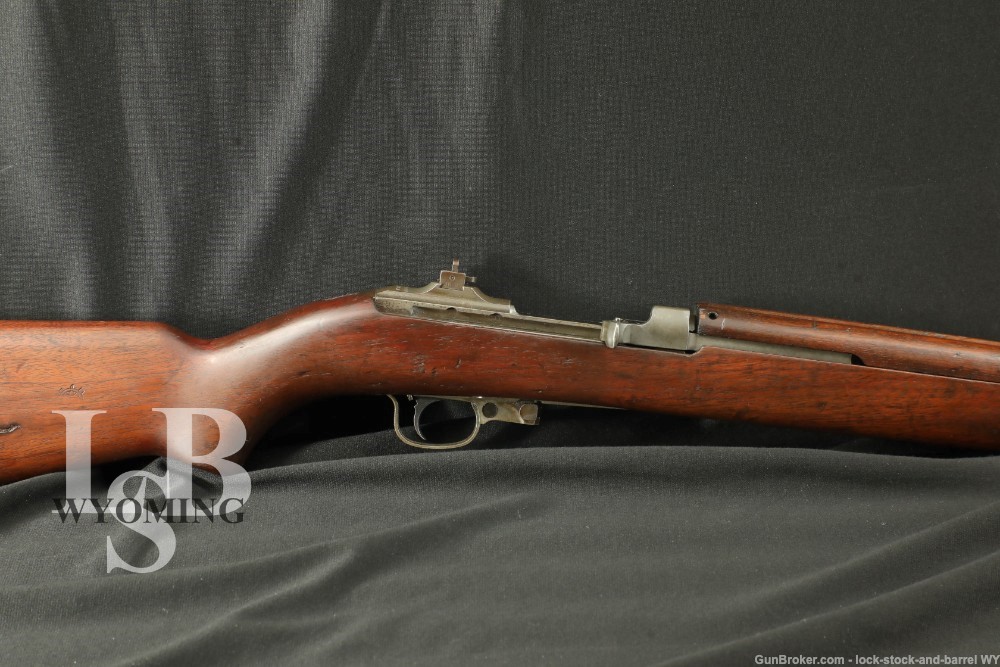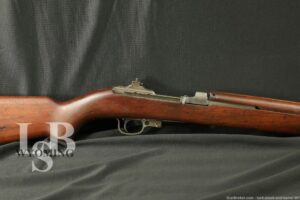
WWII International Business Machine Corp. IBM M1 Carbine .30 Cal Rifle C&R
SOLD FOR: $1,674.00
WOA#: WY240406WM019
Make: International Business Machine Corp., IBM
Model: M1 Carbine
Serial Number: 3672753
Year of Manufacture: Circa February 1944
Caliber: .30 Cal Carbine
Action Type: Semi-Automatic carbine fed by detachable magazines.
Markings: The top of the receiver is marked, “U.S. CARBINE CAL. 30 M1 / I.B.M. CORP. / 3672753”.
The magazine release is marked “PR-8”.
The right side of the rear sight is marked with “INB” the left is marked with an “S”.
The Trigger group is marked “BE-B”.
The Crossbolt safety is marked “EPB”
The left side of the hammer is marked “AMB”
The slide is unmarked.
The barrel band sling swivel is marked “KV B”.
The top of the barrel is marked “P” just in front of the barrel band. The top of the barrel is marked “I.B.M. CORP. / 9-43” with a flaming bomb ordnance mark.
The front sight is marked “N”.
The stock has a “P” acceptance mark on the pistol grip, and a part of a crossed cannon mark on the right side of the stock. The sling cut out is marked “M-U”.
Barrel Length: 18″
Sights / Optics: The front sight is a fixed blade with protective ears. The rear sight is an early style L type aperture sight dovetailed to the receiver.
Stock Configuration & Condition: The stock is a Type II (High wood) M1 stock with a checkered metal Buttplate, upper handguard with deep groove and 2 rivets, and Type I Barrel Band. The safety lever is a cross bolt safety. The LOP measures about 13.25” from the front of the trigger to the back of the buttplate. The stock shows compressions and dings scattered throughout with a small chip near the sling cut out and a chip out of a knot on the side of the stock that has been covered with finish. The handguard also shows minor dings and a small chip near the receiver. Overall the Wood is in Very Good condition for C&R.
Magazine Quantity & Condition: None.
Type of Finish: Parkerized
Finish Originality: Original
Bore Condition: The bore is bright, with shallow visible rifling and no visible erosion. In this writer’s opinion the bore rates 8.5/10.
Overall Condition: This rifle retains about 95% of the original finish. There are many spots on the rifle that have turned brown with patina and there are some very light scattered patches of surface rust on the barrel. The friction surfaces are fairly clean, except the bolt which has lost its finish on the friction surfaces. Overall this rifle is in Very Good condition considering its age for C&R.
Mechanics: The action functions correctly. We did not fire this rifle. As with all used firearms, a thorough cleaning may be necessary to meet your maintenance requirements.
Box, Paperwork & Accessories: None.
Our Assessment: During the early stages of World War II, the U.S. military recognized the need for a lightweight rifle that would bridge the gap between the heavy and cumbersome M1 Garand rifle and the standard issue sidearm, the M1911 pistol. The goal was to provide troops with a compact and easy-to-handle firearm that offered more firepower than a pistol but was lighter and more maneuverable than a full-size rifle. In 1941, the U.S. Army’s Ordnance Department contracted with various manufacturers, including Winchester, General Motors’ Inland Division, and IBM, who would later go into the computer business, to develop and produce the M1 Carbine. The rifle was designed by a team led by firearms designer David Williams, who drew inspiration from the successful M1 Garand and the short-recoil action of the M1 Thompson submachine gun. The M1 Carbine featured a gas-operated, semi-automatic action and fired a .30 caliber cartridge known as the .30 Carbine. The cartridge, while less powerful than the standard .30-06 ammunition used in the M1 Garand, offered greater capacity and reduced recoil, making it more controllable and well-suited for short to medium-range engagements. The M1 Carbine saw widespread use in World War II, becoming a staple firearm for American troops. It was praised for its reliability, ease of use, and versatility. The rifle was not only issued to U.S. forces but also provided to allied nations through various lend-lease programs. After World War II, the M1 Carbine continued to serve in the Korean War and saw limited use in subsequent conflicts. It also became popular among civilian shooters and collectors due to its historical significance and manageable recoil. Overall, the M1 Carbine played a significant role in U.S. military history, offering a lightweight and reliable firearm that filled a niche between pistols and full-size rifles. Its compact design, firepower, and ease of use made it a favored weapon among soldiers in various roles and contributed to its enduring legacy. Please see our photos and best of luck with your bidding!!!-R.L.

